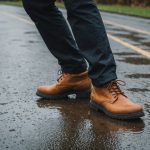Selecting Non-Slip Footwear for Rainy Conditions
When choosing non-slip footwear for the often wet UK climate, safety is paramount. Ensuring shoes have excellent grip and traction is crucial to prevent slips and falls on damp surfaces. The ideal footwear should combine durable materials with thoughtful design features, providing a reliable footing even in pouring rain.
Importance of Grip and Traction
To achieve optimum safety, footwear must feature specially designed soles that maximise traction. Look for deep tread patterns and materials like rubber, renowned for their superior water-handling capabilities. These materials can significantly reduce accidents by preventing sliding on wet paths and pavements.
Also to see : Discover the Best Destinations for Bespoke Knitwear in the UK
Recommended Features in Non-Slip Footwear
When shopping for rainy climate footwear, consider attributes such as water-resistance, ankle support, and a snug fit. Waterproof membrane linings keep feet dry, while cushioned insoles offer added comfort. In addition, flexible but sturdy uppers aid in maintaining equilibrium on unstable, slippery grounds.
Top Brands and Styles for the UK Climate
Several brands excel in producing footwear suitable for the UK’s frequent rain. Names like Hunter, Clarks, and Timberland deliver designs that adeptly combine style and functionality. Their products often feature innovative technologies specifically targeting increased footwear effectiveness and resilience against the UK’s constant showers.
Also read : Essential Suede Shoe Care: Mastering Maintenance in Humid UK Weather
Effectiveness of Non-Slip Footwear in Wet Conditions
In the often rainy UK climate, footwear effectiveness hinges significantly on non-slip traction and wet weather performance. The importance of materials for non-slip soles cannot be understated. Opt for soles crafted from high-quality rubber, as this material excels in non-slip traction by offering a firm grip on slippery surfaces. Whether you’re navigating city pavements or countryside footpaths, these soles enhance footwear effectiveness by ensuring stability.
Design Elements Enhancing Traction
To maximize wet weather performance, pay attention to the design elements incorporated into footwear. Deep tread patterns are particularly beneficial for their ability to channel water away from the contact surface, preventing slips. Moreover, strategically placed grooves on the soles contribute to an enhanced grip, making every step secure. These features collectively bolster the footwear’s effectiveness during wet conditions.
Case Studies of Performance in Rainy Environments
Numerous case studies underline the superior performance of non-slip footwear in rainy environments. Tests conducted across various terrains—from urban wet streets to muddy rural routes—consistently demonstrate an improvement in safety. Individuals reported fewer slips and a heightened sense of security, clearly indicating the tremendous impact that effective non-slip traction can have during the UK’s torrential showers.
Preventing Pilling on Merino Wool Sweaters
Caring for your merino wool sweater requires understanding how to prevent annoying pilling. Pilling occurs when fibers in the sweater knot together, forming unsightly balls. It is typically caused by friction during wear or improper washing techniques. Understanding the root causes allows for implementing effective merino wool care practices.
Understanding What Causes Pilling in Merino Wool
To prevent pilling, consider how your sweater maintenance routine impacts the fibers. Avoid excessive abrasion from rough surfaces or frequent contact with other clothing items. Knit density also influences pilling susceptibility—looser weaves are more prone to fiber movement.
Best Practices for Washing and Drying Merino Wool
Proper washing safeguards delicate wool fibers. Opt for gentle, cold water cycles using mild – wool-specific detergents. Always turn the sweater inside out to protect it from harsher surfaces. For drying, air drying flat helps maintain its shape and minimise the risk of pulling. Using a drying rack further reduces surface contact that contributes to pilling.
Recommended Products to Prevent and Remove Pilling
Products like sweater combs and electric shavers efficiently remove existing pills, restoring a smooth appearance. To prevent pilling, consider using a fabric conditioner specifically designed for wool. This can lubricate the fibers, reducing friction-induced wear for better sweater maintenance.
Expert Advice on Caring for Merino Wool
Merino wool is treasured for its softness and warmth. Nonetheless, it requires careful maintenance. Here, we provide wool care tips to keep your merino sweaters looking their best while avoiding common issues like pilling.
Choosing the Right Detergent
Selecting an appropriate detergent is key in sweater maintenance advice. Always use a mild detergent specifically designed for wool, which cleans gently, preserving the fibres. Avoid regular detergents, as they often contain harsh chemicals that can damage or shrink the delicate fabric. A good wool detergent ensures the natural oils in the merino fibres are retained, providing ongoing protection against wear.
Storage Solutions to Minimize Wear
Proper storage significantly impacts the longevity of merino wool products. Store your sweaters flat and folded, away from direct sunlight, to avoid stretching or fading. Use breathable storage bags to protect from dust while allowing air circulation. Hanging sweaters is not recommended as it may lead to misshaping.
Repairing Pilled Sweaters: Do’s and Don’ts
When dealing with pilled sweaters, approach with caution. Do use a sweater comb or an electric shaver to remove pills, ensuring a gentle touch. Don’t pull or cut pills with scissors, as this can create holes. Regular de-pilling helps maintain the garment’s pristine look.










